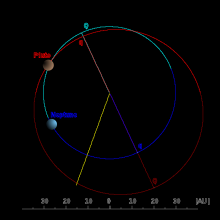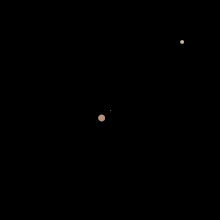Pluto
![]()
This article is about the dwarf planet. For other meanings, see Pluto (disambiguation).
Pluto is the largest and second most massive known dwarf planet in our solar system and the longest known object in the Kuiper belt. It moves in an even more eccentric orbit around the Sun than the planet Mercury. Its volume corresponds to about one third of the Earth's moon.
The astronomical symbol of Pluto is ♇; in astrology is also![]() used. It is named after the Roman god of the underworld. In turn, the new classes of plutoids and plutinos were named after the dwarf planet.
used. It is named after the Roman god of the underworld. In turn, the new classes of plutoids and plutinos were named after the dwarf planet.
From its discovery on 18 February 1930 until the redefinition of the term "planet" on 24 August 2006 by the International Astronomical Union (IAU), Pluto was considered the ninth and outermost planet of the solar system. After more and more plutoids - similar sized bodies of the Kuiper belt - were found, a more precise definition of the term was developed. Since then, it has been assigned to the category of dwarf planet and given the minor planet number (134340) Pluto.
In January 2006, New Horizons was the first spacecraft to be sent to Pluto; it passed it at a distance of 12,500 km on July 14, 2015.
Orbit and rotation
Web
Pluto takes 247.94 years to orbit the Sun. Compared to the planets, Pluto's orbit is significantly more eccentric, with an eccentricity of 0.2488. This means that its distance from the Sun is up to 24.88% smaller or larger than the major semimajor axis.
The furthest point of Pluto's orbit from the Sun, aphelion, is 49.305 AU, while the closest point to the Sun, perihelion, is 29.658 AU, closer to the Sun than Neptune's very slightly eccentric orbit. The last time Pluto passed through this region, where it is closer to the Sun than Neptune's orbit, was from February 7, 1979 to February 11, 1999. Pluto passed through perihelion in 1989, and it will reach its aphelion in 2113. There the solar radiation is only about 0.563 W/m². On Earth it is 2430 times as high. To an observer on Pluto, the Sun's apparent diameter is only about 50″, making it look like a blindingly bright star of about the -19th magnitude (150× brighter than the full Moon). It varies by about 1.1 magnitudes during a Pluto year.
Due to Pluto's strongly eccentric orbit and the different albedo of its two hemispheres, its brightness, seen from Earth, changes between 13.8 mag (near Earth) and 16.5 mag (far Earth).
It is striking that Pluto moves exactly twice around the Sun during the time in which Neptune moves three times around the Sun. This is therefore called a 3:2 orbital resonance. Many of the Kuiper Belt objects, like Pluto, are in a 3:2 orbital resonance with Neptune and are called plutinos. Using methods of celestial mechanics, it can be shown that their typically very eccentric orbits are stable over millions of years.
Pluto was thought to be an escaped moon of Neptune until the discovery of many other similar objects. Its distinctly eccentric orbit, strongly inclined at 17° to the ecliptic, and small size suggested this. The large moon of Neptune, Triton, is thought to have been captured by Neptune, considerably disturbing the original lunar system: Pluto was said to have been catapulted out of the Neptune system as a result, and the considerable orbital eccentricity of Neptune's moon Nereid was created. Triton's retrograde orbital sense argues for its capture, which is why this remains the accepted theory for Triton. However, the hypothesis of an escaped Pluto has since been dropped. The discovery of numerous other transneptunian objects at the edge of the planetary system has proven that Pluto is the largest and in any case the brightest representative of the Kuiper belt, a cluster of thousands of asteroids and comet nuclei in a disk-shaped region behind the orbit of Neptune. Pluto's formation history is thus closely linked to that of the Kuiper belt, which consists of remnants of the formation of the outer planetary system. Triton is also said to have been a member of this belt before its presumed capture.
.png)
Rotation
Pluto rotates once around its axis in 6.387 days. The equatorial plane is inclined at 122.53° to the orbital plane, so Pluto rotates retrograde. Its axis of rotation is thus even more inclined than that of Uranus. Unlike Uranus and Venus, the reason for this is generally apparent, as is the cause of Pluto's large rotation period compared to other celestial bodies, because the dwarf planet's proper rotation is tied by tidal forces to the orbital motion of its very large moon Charon. Pluto and Charon were the first and for a long time the only known bodies in the solar system with a double-bound rotation, until similar systems were found in the Kuiper belt as well as in the asteroid belt, such as (90) Antiope with its companion Antiope B.
The determination of the poles for the dwarf planet was done in such a way that its north pole is that pivot point at which the rotation of the surface runs counterclockwise. Due to Pluto's retrograde sense of rotation, the axial direction of its north pole, unlike that of the planets, points south of the ecliptic.

The orbit of Pluto (red) compared to that of Neptune (blue); object sizes not to scale. The bright orbital regions lie north of the ecliptic, the dark ones south. The yellow section connects the Sun with the vernal equinox.

Pluto in a rotation animation
Moons
Five natural satellites are known from Pluto. Their orbits are approximately circular and complanar to each other. They lie in Pluto's strongly inclined equatorial plane, not in its orbital plane. To the orbital period of the dominant Charon, the orbital periods of the other, outer moons are approximately resonant; the ratios are about 1:3:4:5:6.
With Charon, Pluto has a relatively large moon, which is why it is sometimes referred to as the "double system Pluto-Charon". The size ratio is even smaller than that of the Earth-Moon system and is less than 2:1 in terms of diameter. Due to the mass ratio of a good 8:1 and a distance of just under 15 Pluto radii, the common center of gravity, the barycenter of the system, lies outside of Pluto. Thus Charon and Pluto orbit each other.
The four smaller satellites move approximately around the common center of gravity of Pluto and Charon, so in the long term the orbit of all of them is probably unpredictable (three-body problem). Due to the non-uniformly interacting gravitational fields of Pluto and Charon, they also do not have bound rotation like Charon; moreover, their rotational axes are highly inclined and their rotational behavior is also not constant over time. The shape of Kerberos and Hydra speaks for a merger of two smaller bodies each.
The origin of the Pluto moons is explained after the model of the collision theory for the origin of the earth moon by the grazing collision of Pluto with another large body of the Kuiper belt, by which debris got into orbits around Pluto, from which the moons were formed there. This common theory was used for Charon before the discovery of the four small ones. The complanar orbits with the nearly resonant orbital periods as well as the uniformly colored surfaces speak for a common origin of all Pluto moons. In case of a capture a different colouring would have been expected.
Pluto and its moons are subjected to a constant bombardment of minimeteors in the Kuiper belt, which knock dust and ice particles out of their surfaces. While the gravity of Pluto and Charon ensures that all debris falls back onto the celestial bodies, the gravitational pull of the smaller moons is not sufficient for this. Therefore, scientists suspect that these will lose so much material in astronomical time periods due to further impacts that a dust ring will gradually form around Pluto.
The discovery of further Pluto moons was unexpected, since no celestial body with more than one satellite had been observed beyond Neptune until then; however, already one month later a second moon was found at (136108) Haumea. Since Pluto and Charon can be regarded as double (dwarf) planets with some justification, Nix and Hydra can also be seen as the first evidence for circumbinary satellites with reasonably stable orbits in a binary system.
Before the flyby, New Horizons was again intensively searched for satellites and dust rings for safety reasons; however, no further Pluto moons could be discovered. Should they nevertheless exist, they could have at most about a quarter of the brightness of the small, dark Kerberos.
| Name | Discovery | Object | Path parameters | Brightness | |||||||
| Image | Diameter | Mass | Large half-axis | Turnaround time | Excen-tricity | Inkli-nation | Max. | Ø | Min. | ||
| Charon | 1978 |
| 1212 | 1587 | 17 536 ± 3* | 06,387 230 | 0,002 2 | 0,001° | 15,8m | 16,8m | 18,3m |
| Nix | 2005 |
| ≈ 49,8 × 33,2 × 31,1 | ≤ 0,09 | 48 690 ± 3* | 24,854 800 | 0,000 00 | 0,0° | 23,3m | 24,4m | 24,9m |
| Hydra | 2005 |
| ≈ 50,9 × 36,1 × 30,9 | ≤ 0,09 | 64 721 ± 3* | 38,202 100 | 0,005 54 | 0,3° | 22,9m | 24,0m | 25,2m |
| Kerberos | 2011 |
| ≈ 12 × 4,5 | ≤ 0,03 | 57 750 ± 3* | 32,167 900 | 0,000 00 | 0,4° | 25,7m | 26,8m | 28,1m |
| Styx | 2012 |
| ≈ 16 × 9 × 8 | 0,007 5 | 42 656 ± 78 | 20,161 550 | 0,000 01 | 0,0° | 26,6m | 27,7m | 29,0m |
Comment
- Max. : Pluto perihelion, conjunction, brightest side facing Earth.
Min : Pluto aphelion, opposition, darkest side facing Earth

enlarge and show information about the picture
![]()
Pluto and its moons to scale with barycenter

Pluto and Charon orbit each other (graphic). The barycenter (white dot in the middle) lies outside of Pluto.
Questions and Answers
Q: What is the formal name of Pluto?
A: The formal name of Pluto is 134340 Pluto.
Q: How large is Pluto compared to the Earth's Moon?
A: Pluto is about a fifth (⅕) of the weight of the Earth's Moon and only a third (⅓) of its volume.
Q: When was Pluto reclassified as a dwarf planet?
A: In 2006, Pluto was reclassified to a dwarf planet.
Q: What is the average temperature on Pluto?
A: The average temperature on Pluto is -226 to -240 degrees Celsius.
Q: How far away from the Sun does it take for Pluto to orbit?
A: It takes 30 to 49 AU (4.4–7.4 billion km) from the Sun for Pluto to orbit around it.
Q: Who discovered Eris and other objects like it in early 21st century?
A: In early 21st century, scattered disc object Eris and other objects like it were discovered by astronomers.
Q: Why did some scientists disagree with downgrading Pluto in 2006?
A: Some scientists disagreed with downgrading Plutos classification because they believed that it should still be classified as a planet instead of a dwarf planet.
Search within the encyclopedia



.jpg)
.jpg)